Registering Domain Name & Blog Hosting: Installing WordPress
What You Will Learn
- Website Lingo – Hosting, Website & Domain name
- Picking your domain name
- How to setup your domain name and blog hosting account
- Installing WordPress
Now that you understand WordPress.com vs. WordPress.org and the difference between Self Hosting and free platforms, let’s dive into getting you setup with a Self Hosting account.
Website Lingo
Hosting
Hosting is like a house before you first move in. There’s no furniture, appliances or electronics… it’s completely empty. The sole purpose of a house is to provide shelter and a space to securely store all “your stuff.”
Hosting is like a empty house… your own space on the web.
Website
A website is built from a series of multiple folders and files. For it to work properly and be seen by others, you need a place to store all this information.
Essentially, a website is like your furniture, appliances, electronics…(“your stuff”).
Domain
A domain name (website URL) is like your house address. When people type www.yourblogname.com within their browser, they get sent to the location of where your website is hosted (aka the house with all your stuff).
To sum it up:
Hosting = House (a place to store your stuff)
Website = Your stuff in the house
Domain name = House address
In other words, a website is stored on a hosting plan and can be accessed via a domain name.
Blogger, WordPress.com, and other free blogging platforms
Here is where things can get a little confusing.
These are blogging platforms, which mean companies (websites) offer a free blogging service for those wanting to start a blog without the monetary investment. They let you use their hosting and website design features to start your blog.
To follow the theme of our previous example:
Blogging Platforms could be viewed as an extended stay hotel. Meaning, a fully furnished room (not your furniture) to store a few of your things.
Conclusion
In my experience, owning my own site (with domain and hosting) has given me the flexibility and creative control to make my blog exactly how I want it.
If you have not started a blog yet, BlueHost (Hosting) is reasonably priced and easy to setup. It will also be the hosting provider used within these tutorials. Click Here to get your own domain and hosting setup via BlueHost.
If you are looking to make the switch from Blogger or other various blogging platforms, please send me an e-mail (brittany@thriftsandthreads.com) as each situation is different. It’s alot of work, but if you are looking to get onto WordPress.org, you will need to switch over and I can give you more specific advice depending on your need.
Picking Your Domain Name
Hopefully you’ve read my post on finding your niche, as it would point you in the right direction on figuring out the main theme of your blog. Once you have strategically planned the idea of your blog, now comes the fun part, picking out a name!
I remember it was Thanksgiving week 2013, my husband and I were on the couch at his parents house in Texas throwing around the idea of starting a blog and thinking of names for fun. I knew what I wanted as far as my niche, but had a hard time coming up with a name. I wanted to be original but also something that would be rather easy to remember. LOL the first names I came up with were all jokes and super lame- it was definitely a fun (and entertaining process!
You may already have your name, but for those who are stuck…here’s a fun little exercise:
Write down the first 5 keywords that come to mind when you think of your blog.
For me this is what I came up with:
– Thrift Stores
– Affordable fashion
– Budget friendly
– Vintage clothes
– Affordable style
Find synonyms for those keywords.
Use Thesaurus.com, it will give you some quick ideas.
thrift = saving, frugality, thriftiness,
affordable = cheap, low-cost, bargain, steal
budget = cost, funds, allowance
vintage = classical, mature, rare, classic, prime
clothes = attire, clothing, wardrobe, rags
fashion = fad, vogue, look,
Come up with a catchy, yet memorable name using the keywords.
I like to incorporate some alliteration, but you don’t necessarily have to. List as many names that come to mind:
– cheapchick.com (sounds like chapstick? Not so much)
– classicandcheap.com (the irony)
– bargainbabe.com
– vintagevogue.com
– stealfunds.com (lol not sure if this would be a style blog or a crime forum?)
You get the idea, just “blogstorm” … to quote one of favorite podcast episodes.
Obviously I ended up with thriftsandthreads.com 🙂 Some examples of other blog names using alliteration:
– Damsel in Dior
– Pink Peonies
– Song of Style
– Who What Wear
Have fun with it and always keep in mind:
- Is it easy to read and spell?
- Does it clearly state my blog’s message?
- Do I set myself apart from other Blogger names? (for example, Song of Savings might be too close for comfort)
Configuring your domain name and hosting
There are so many companies out there when it comes to picking out a domain and hosting service provider, but for beginners we recommend…
Having a husband who is very knowledgeable in web design and coding, he recommended I start with BlueHost. He was originally using GoDaddy for hosting other sites we created at the time and even though their customer service is awesome, the overall performance with regards to website speed seemed below par. Also BlueHost offers a free domain name with their hosting plan, GoDaddy does not.
I started with BlueHost initially but as my blog traffic grew, I decided to move over to Synthesis for increased website speeds, which I only recommend using once your traffic grows because it’s a more advance hosting system.
BlueHost is a great beginner option at the best price.
The following outlines the costs for BlueHost so you can get an idea of the cost of Self Hosting:
I went with the “Popular” option as it’s only a $3.00 difference between the two plans, yet you get so much more. But the “Starter” option is fine as well.
That’s $7/month for your own blog that you have complete control over!! (includes domain and hosting) I almost spend that much on coffee everyday…oh Intelligentsia just take my money 🙂
Now there’s a reason why there’s an asterisk next to the $6.95/month. It’s that cost if you commit for 36 months. I know that seems like a big commitment and at this stage you are unsure if you would even be blogging for the long. No problem, you can commit for 24 months at $7.96/mo or 12 months at $8.95/mo. Just don’t go out to lunch for one day out of the month and it’s paid for!
Step-by-Step using BlueHost
So that I walk alongside you during this process, I will be creating a brand new website from scratch. My husband is really starting to get more involved in photography and would like to have an online portfolio, so I thought it would be fun to create him a killer blog and that way we can walk through the steps more in detail together as this series continues over the next few weeks.
Here is what I did, step by step (super easy):
1. Go to www.bluehost.com
2. Select your plan option. I would go with the “Plus” package, better value.
3. Now enter in the Domain name you decided to go with. He decided on www.anthonyrxavier.com
Make sure to have a few options just in case the one you want is already taken. We got lucky and his was available.

4. Enter in all your account and payment information. You want your “Package Information” to look like the screenshot below:

Obviously if you want your package longer than 12 months to save some money, change it.
I want to briefly describe what you see above:
- Constant Contact: Email Marketing service that we will go over in a later post.
- Domain Privacy: Protects all your information and keeps it private. Highly suggest this.
- Site Backup Pro: We will install a plugin later, so no need for this service.
- Search Engine Jumpstart: I will discuss SEO more in depth later.
- SiteLock Security: Install a plugin later, no need.
5. Skip all the Extras and scroll to the bottom and hit “Complete”.
6. You will be asked to create a password, go ahead and create one.
7. You will then be presented with two options: “I can do it” or “Do it for me”

Select “I can do it” and then you will be taken to your dashboard, which is the backend of your website.
And there you have it!
You just created a website! See, it wasn’t that hard 🙂
Now if you visit my husband’s site www.anthonyrxavier.com, you will see a BlueHost landing page. Don’t worry, it’s normal. At this point I don’t have WordPress installed nor any website templates.
Overview
Ok soooo… (I promised in a recent Snap that I would stop using that phrase, but can’t help it) let me just reiterate, I didn’t know anything about blogging when I first started. I was lucky to marry a guy that is totally techie obsessed and taught himself how to code via friends and online tutorials, but that’s not the case with most of you and I get it.
You don’t need a techie hubs or to have a degree in computer science to do this. After learning from him and literally falling in love with all things website building- I realized it can seem overwhelming at first but it’s really not if you take the time to go through it step by step. And that’s what I am going to show you.
Installing WordPress
Just a quick and simple clarification before we get started…
WordPress.com = Free blogging platform service
WordPress.org = A CMS (Content Management System) that will be installed on your hosting plan and used to run your blog. It makes running a blog so much easier and has a very similar setup to WordPress.com with more customization/features. It’s also what I use.
Let’s get started!
1. Log in to your hosting account – BlueHost Server Login
You should have received your login information via email.
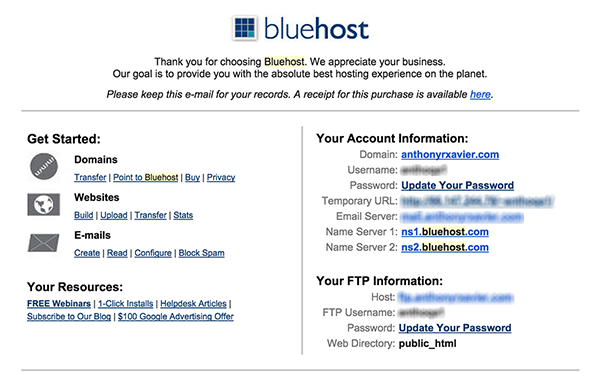
2. Scroll down and under “Website” click “Install WordPress”.
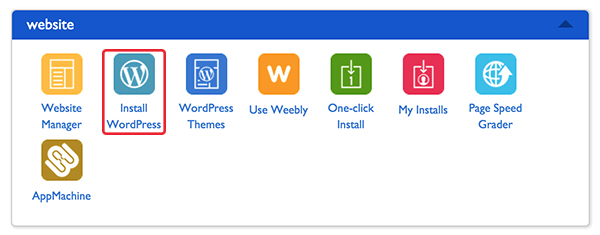
3. Click the BIG GREEN install button.
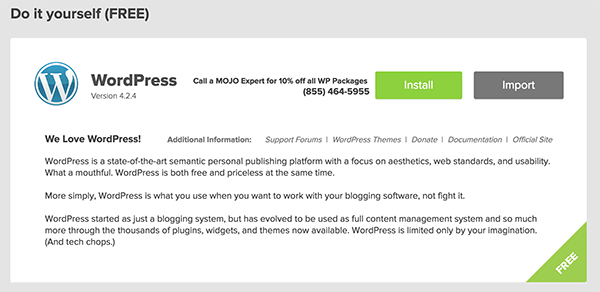
4. Since this new hosting account is really meant to store one website, I will install WordPress in the root directory and leave the directory blank.
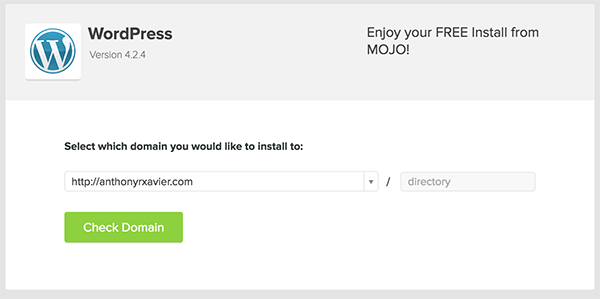
5. Click “Show advanced options” and change Site Name, Username and Password. Agree to the terms and click “Install Now”.
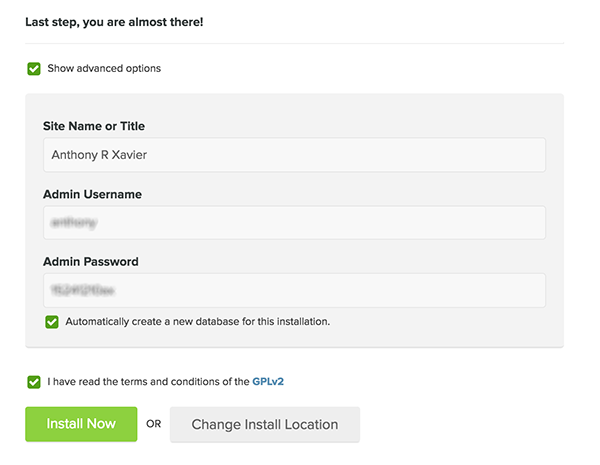
Installation will begin and once installed, you will be sent an email with your login URL and credentials for WordPress.
6. Log into WordPress!
The URL to access WordPress will look something like this:
www.yourblogname.com/wp-admin
Then use the credentials you entered in on the previous step. Your dashboard will look like the below.
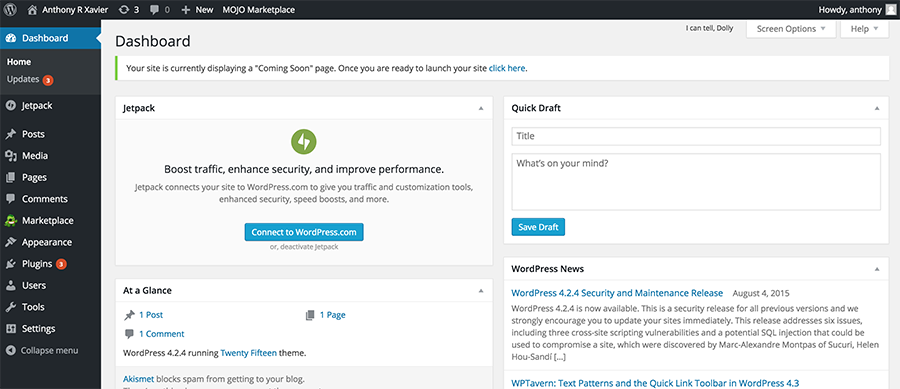
And there you have it, your own WordPress blog!
Resources: Website Hosting – BlueHost
Next week the post will be quite a bit longer, as I will be diving into all things WordPress (yay!…my fav) discussing how to use it, proper setting configuration and installing my favorite plugins.
Per usual, feel free to leave comments below and I will answer as best as I can!
Happy blogging!
xx Brittany

